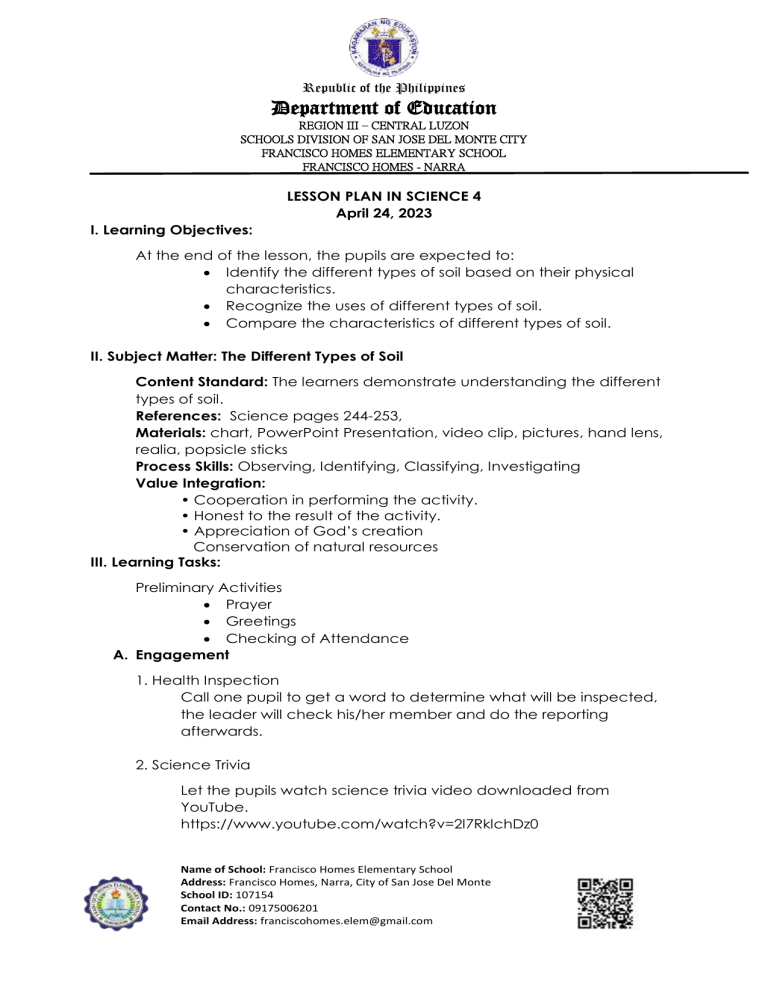
Republic of the Philippines Department of Education REGION III – CENTRAL LUZON SCHOOLS DIVISION OF SAN JOSE DEL MONTE CITY FRANCISCO HOMES ELEMENTARY SCHOOL FRANCISCO HOMES - NARRA LESSON PLAN IN SCIENCE 4 April 24, 2023 I. Learning Objectives: At the end of the lesson, the pupils are expected to: Identify the different types of soil based on their physical characteristics. Recognize the uses of different types of soil. Compare the characteristics of different types of soil. II. Subject Matter: The Different Types of Soil Content Standard: The learners demonstrate understanding the different types of soil. References: Science pages 244-253, Materials: chart, PowerPoint Presentation, video clip, pictures, hand lens, realia, popsicle sticks Process Skills: Observing, Identifying, Classifying, Investigating Value Integration: • Cooperation in performing the activity. • Honest to the result of the activity. • Appreciation of God’s creation Conservation of natural resources III. Learning Tasks: Preliminary Activities Prayer Greetings Checking of Attendance A. Engagement 1. Health Inspection Call one pupil to get a word to determine what will be inspected, the leader will check his/her member and do the reporting afterwards. 2. Science Trivia Let the pupils watch science trivia video downloaded from YouTube. https://www.youtube.com/watch?v=2l7RklchDz0 Name of School: Francisco Homes Elementary School Address: Francisco Homes, Narra, City of San Jose Del Monte School ID: 107154 Contact No.: 09175006201 Email Address: franciscohomes.elem@gmail.com Republic of the Philippines Department of Education REGION III – CENTRAL LUZON SCHOOLS DIVISION OF SAN JOSE DEL MONTE CITY FRANCISCO HOMES ELEMENTARY SCHOOL FRANCISCO HOMES - NARRA 3. Review: Write YES if the statement is correct or NO if it is not. ______ 1. The loudness of the sound refers to how strong the sound seems to us when it reaches our ears. ______ 2. The sound is heard louder if we are near the source and then gradually fades or becomes softer as we move away from it. ______ 3. Car blowing of horn and seemingly endless barking of a dog are example of noise. ______ 4. Sound travels in solids, in liquids, and in gasses. Sound travels the fastest through solid, then liquid, and slowest in gas. ______ 5. We always hear an echo even when the original sound is too weak. Answer key: 1. Yes, 2. Yes, 3. Yes, 4. Yes, 5. No Emphasize that a sound wave travels at different speed through different media. 4. Motivation: Activity 1: Collecting sample of soil. Procedure: 1. Show three samples of soil then label each sample A, B, and C. 2. Scoop at least two tablespoons of soil from each sample. 3. Place each sample on a separate bond paper. 4. Using a popsicle stick, observe each sample. 5. Write your observation on your science notebook using the table below then let 1 to 3 pupils to present their observation. Soil A B C Soil Characteristics Color Texture Name of School: Francisco Homes Elementary School Address: Francisco Homes, Narra, City of San Jose Del Monte School ID: 107154 Contact No.: 09175006201 Email Address: franciscohomes.elem@gmail.com Odor Republic of the Philippines Department of Education REGION III – CENTRAL LUZON SCHOOLS DIVISION OF SAN JOSE DEL MONTE CITY FRANCISCO HOMES ELEMENTARY SCHOOL FRANCISCO HOMES - NARRA Guide Questions: 1. What common characteristics did you observe on your sample? 2. Do the samples have the same color, texture, and odor? Why do you think so? 3. What do you think is the type of soil that you observed 4. Define soil in your own words? 5. Presentation Ask the learners the following processing questions based on their observation: a. How do you find the activity? b. What are the different types of soil? c. Which of the types of soil you already see in person? d. What did you learn from this activity? B. Exploration 1. Setting Standards during Group Activity a. Avoiding unnecessary noise during group activity. b. Focus and cooperation in all activities. c. Write down important notes to gather information. d. Observed discipline. Activity 2: Observe the characteristics of soil when wet. Materials: 3 packs soil sample, water, chart, marking pen, 3 pcs plastic spoon, 3 pcs plastic cups, stop watch Procedures: 1. Divide the class into 3. 2. Prepare the materials needed for the activity. 3. Using a chart, write your observation. (refer to the chart below) 4. If you’re done with the activity you will have to clap three times and shout the Group’s name. 5. After a specific time, each group will present / report and post their observations. Name of School: Francisco Homes Elementary School Address: Francisco Homes, Narra, City of San Jose Del Monte School ID: 107154 Contact No.: 09175006201 Email Address: franciscohomes.elem@gmail.com Republic of the Philippines Department of Education REGION III – CENTRAL LUZON SCHOOLS DIVISION OF SAN JOSE DEL MONTE CITY FRANCISCO HOMES ELEMENTARY SCHOOL FRANCISCO HOMES - NARRA Characteristics Cup No. Color Texture Observation Before Adding Water After Adding Water No. of Minutes the water is absorbed A B C C. Explanation / Reporting Discussion on the result of each activity 1. What did you observe when you added water to each soil sample? 2. In which cup or sample was water absorbed the fastest? How fast was it absorbed? Why do you think so? 3. In which cup of sample was water absorbed the slowest? How slow was it absorbed? Why do you think so? 4. Is there a change in the appearance or texture of each soil sample after you poured water on it? Why or why not? 5. What does the activity show? Discuss the three types of soil and the layers of soil thoroughly. Remember these: Soil covers most of the land part of the earth. You find plants, animals, houses, and other organisms on the soil. We live in a soil, and it helps us in many ways. Different types of soil have different physical characteristics. Each soil type differs in color, textures, odor, and its ability to hold water. Some soils are good for planting while others are not. The presence of the different kinds of vegetative plants Name of School: Francisco Homes Elementary School Address: Francisco Homes, Narra, City of San Jose Del Monte School ID: 107154 Contact No.: 09175006201 Email Address: franciscohomes.elem@gmail.com Republic of the Philippines Department of Education REGION III – CENTRAL LUZON SCHOOLS DIVISION OF SAN JOSE DEL MONTE CITY FRANCISCO HOMES ELEMENTARY SCHOOL FRANCISCO HOMES - NARRA in a place is evidence of a good quality of soil in the area or locality. Sometimes a combination of soil is observed in some areas of the country. VALUE FORMATION: Do you have plants at home? How do you take care of plant soil? Why do you need to care for the soil around the plants? D. Elaboration / Generalization • Class do you have question/s? • Did you understand our lesson? • What have you learned from our lesson for today? • (Present the different types of soil and its characteristics using a graphic organizer based on the answer of the pupils.) E. Enrichment: Reminders for Group Activity: The 3 W’s : Work Silently Work Cooperatively Work Neatly Rubrics in Participation/Group Activities Differentiated Instruction Name of School: Francisco Homes Elementary School Address: Francisco Homes, Narra, City of San Jose Del Monte School ID: 107154 Contact No.: 09175006201 Email Address: franciscohomes.elem@gmail.com Republic of the Philippines Department of Education REGION III – CENTRAL LUZON SCHOOLS DIVISION OF SAN JOSE DEL MONTE CITY FRANCISCO HOMES ELEMENTARY SCHOOL FRANCISCO HOMES - NARRA Cooperate with your respective group to come up with an output regarding the different types of soil and its characteristics. Group 1: “SHOW IT OUT” Complete the puzzle image and identify what type of soil is in the picture. Group 2: “SOIL MATCH” Match the type of soil to its characteristics. Group 3: “FILL THE POT” Read the question then write your answer inside the POT. Group 4: “INFORM ME” Create a graphic organizer of the different types of soil and its characteristics. Group 5: “NAME ME” Label the layer of the soil. Each group will present their output. They will be graded based on the rubric presented by the assigned group and the teacher. Group 1 will be graded by Group 2, Group 2 by Group 3, Group 3 by Group 4, Group 4 by Group 5, and Group 5 by Group 1. IV. Evaluation Directions: Choose the letter of the correct answer. 1. How many types of soil are there? a. 1 b. 2 c. 3 d. 4 2. Which soil hold much water? a. Loam b. sand c. clay d. silt 3. Which of the soil type is good in making pots? a. Clay b. loam c. soil d. silt 4. How does decayed organisms like plants and animals make soil fertile? a. Change its color c. makes the texture finer b. Enhances a color d. add nutrients to the soil 5. What type of soil do you usually expect in a shoreline? Name of School: Francisco Homes Elementary School Address: Francisco Homes, Narra, City of San Jose Del Monte School ID: 107154 Contact No.: 09175006201 Email Address: franciscohomes.elem@gmail.com Republic of the Philippines Department of Education REGION III – CENTRAL LUZON SCHOOLS DIVISION OF SAN JOSE DEL MONTE CITY FRANCISCO HOMES ELEMENTARY SCHOOL FRANCISCO HOMES - NARRA a. Clay b. loam c. sand d. a and c Answer Key: 1. C, 2. A, 3. A, 4. D, 5. C V. Assignment 1. List three (3) plants that grow in loam soil, sand, and clay. 2. What are the different sources of water suitable for human Consumption? “Write it on your Science notebook.” Prepared by: AILENE B. SIEGA Teacher I Checked by: SUSAN M. INDAYA Master Teacher II Name of School: Francisco Homes Elementary School Address: Francisco Homes, Narra, City of San Jose Del Monte School ID: 107154 Contact No.: 09175006201 Email Address: franciscohomes.elem@gmail.com


